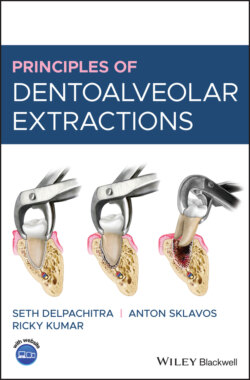Principles of Dentoalveolar Extractions

Реклама. ООО «ЛитРес», ИНН: 7719571260.
Оглавление
Seth Delpachitra. Principles of Dentoalveolar Extractions
Table of Contents
List of Tables
List of Illustrations
Guide
Pages
Principles of Dentoalveolar Extractions
Foreword
About the Companion Website
1 Principles of Surgery
1.1 Wound Healing
1.1.1 Haemostasis
1.1.2 Inflammatory Phase
1.1.3 Proliferative Phase
1.1.4 Remodelling and Resolution
1.2 Patient Assessment
1.3 Radiographic Assessment
1.4 Informed Consent
1.5 Anaesthesia
1.6 Preparation of Equipment
1.7 The Surgeon's Preoperative Checklist
1.8 Operative Note
2 Local Anaesthesia
2.1 Principles of Anaesthesia
2.2 Mechanism of Action
2.3 Common Local Anaesthetic Preparations
2.4 Side Effects and Toxicity
2.4.1 Local Risks
2.4.2 Systemic Risks
2.5 Basic Oral Anaesthesia Techniques
2.5.1 Buccal Infiltration Anaesthetic
2.5.2 Mandibular Teeth
2.5.2.1 Conventional ‘Open‐Mouth’ Technique
2.5.2.2 Akinosi ‘Closed‐Mouth’ Technique
2.5.2.3 Gow–Gates Technique
2.5.2.4 Mandibular Long Buccal Block
2.5.2.5 Mental Nerve Block
2.5.3 Maxillary Teeth
2.5.3.1 Greater Palatine Block
2.5.3.2 Palatal Infiltration
2.5.3.3 Nasopalatine Nerve Block
2.5.3.4 Posterior Superior Alveolar Nerve Block
2.6 Adjunct Methods of Local Anaesthesia
2.6.1 Intraligamentary Injection
2.6.2 Intrapulpal Injection
2.7 Troubleshooting
3 Basic Surgical Instruments
3.1 Retractors
3.2 Elevators, Luxators, and Periotomes
3.3 Dental Extraction Forceps
3.4 Ancillary Soft Tissue Instruments
3.5 Suturing Instruments
3.6 Surgical Suction
3.7 Surgical Handpiece and Bur
3.8 Surgical Irrigation Systems
3.9 Mouth Props
4 Simple Extraction Techniques
4.1 Maxillary Incisors
4.2 Maxillary Canines
4.3 Maxillary Premolars
4.4 Maxillary First and Second Molars
4.5 Mandibular Incisors
4.6 Mandibular Canines and Premolars
4.7 Mandibular Molars
5 Surgical Extraction Techniques
5.1 General Principles of Surgical Extraction
5.2 Practical Aspects of Surgical Extraction
5.3 Common Soft Tissue Flaps for Dental Extraction
5.4 Bone Removal
5.5 Tooth Sectioning
5.6 Cleanup and Closure
6 Intraoperative Complications
6.1 Lip Burns and Lacerations
6.2 Damage to Adjacent Teeth or Restorations
6.3 Mandible Fracture
6.4 Tooth Aspiration or Ingestion
6.5 Instrument Fracture
6.6 Intraoperative Bleeding
6.7 Oroantral Communication
6.8 Dentoalveolar Fracture
7 Third Molar Surgery
7.1 Treatment Planning of Impacted Third Molars
7.2 Difficulty Assessment and Preoperative Workup
7.3 Radiographic Assessment of Inferior Alveolar Nerve Risk
7.4 Surgical Approach to Third Molars
7.4.1 Maxillary Third Molars. 7.4.1.1 Erupted
7.4.1.2 Unerupted/Partially Erupted
7.4.2 Mandibular Third Molars
7.4.2.1 Mesioangular
7.4.2.2 Distoangular/Vertical
7.4.2.3 Horizontal
7.4.2.4 Full Bony Impaction (Early Root Development)
7.4.2.5 Buccolingual/Other Impactions
8 Management of the Medically Compromised Patient
8.1 Ischaemic Cardiovascular Disease
8.2 Patients with a History of Infective Endocarditis
8.3 Hypertension
8.4 Medication‐Related Osteonecrosis of the Jaws
8.5 Diabetes Mellitus
8.6 Increased Bleeding Risk
8.6.1 Bleeding Diatheses
8.6.2 Medications
8.6.2.1 Management of Antiplatelet Agents Prior to Dentoalveolar Surgery
8.6.2.2 Management of Patients Taking Warfarin Prior to Dentoalveolar Surgery
8.6.2.3 Management of Patients Taking Direct Anticoagulant Agents Prior to Dentoalveolar Surgery
8.7 Adrenal Suppression
8.8 The Irradiated Patient
8.8.1 Management of the Patient with a History of Head and Neck Radiotherapy
8.9 Hepatic or Renal Impairment
8.10 Pregnancy and Lactation
9 Postoperative Care and Late Complications
9.1 Immediate Postoperative Period
9.2 Postoperative Instructions
9.3 Postoperative Medications
9.4 24‐Hour On‐Call Service and Tertiary Hospital Referral
9.5 Management of Late Complications
9.5.1 Alveolar Osteitis
9.5.2 Acute Facial Abscess
9.5.3 Postoperative Haemorrhage
9.5.4 Temporomandibular Joint Disorder
9.5.5 Epulis Granulomatosa
9.5.6 Nerve Injury
Appendix A Special Cases: Common Indications for Surgical Extraction. A.1 Lone‐standing Upper First Molars
A.2 Palatally Impacted Upper Canines
A.3 Bulbous Roots (Hypercementosis)
A.4 Teeth with Aberrant Root Morphology
A.5 Teeth with Extensive Crown Decay
A.6 Retained Deciduous Molars
Appendix B Extraction of Deciduous Teeth
B.1 Principles of Paediatric Dental Extraction. B.1.1 History Taking and Examination
B.1.2 Radiographic Assessment
B.1.3 Consent
B.1.4 Local Anaesthetic
B.1.5 Use of Sedation
B.1.6 Extraction Technique
B.1.7 Outcomes Following Extraction
B.2 Techniques of Paediatric Dental Extraction. B.2.1 Deciduous Incisors and Canines
B.2.2 Deciduous Molars
Bibliography
Index. a
b
c
d
e
f
g
h
i
l
m
n
o
p
r
s
t
v
w
WILEY END USER LICENSE AGREEMENT
Отрывок из книги
Seth Delpachitra Anton Sklavos Ricky Kumar
Tooth removal in the middle of the last century occupied a large part of the dental practitioner’s work and skill set, but this has markedly reduced due to better dental care and tooth maintenance. The time devoted to the discipline of exodontia in the dental curriculum has thus diminished proportionally, and many graduates emerge with minimal experience in removing teeth. A fresh, comprehensive guide to the principles of dentoalveolar extractions for all interested practitioners who wish to underpin their clinical experience with clear guidelines is therefore most welcome.
.....
With our ageing population, there are many medications and diseases that must be thoroughly understood by the dental practitioner. A chapter on medical compromise is an important addition to this text as it covers issues such as the newer anticoagulant agents and medications for bone loss that influence healing. The taking of these drugs may significantly modify a treatment plan, and decisions regarding joint management with the patient’s prescribing physician are often indicated. Finally, postoperative care and complications are discussed, as these represent vital knowledge in surgical care.
Many books covering this field have included chapters devoted to exodontia, as part of a broader spectrum of oral and maxillofacial surgery. However, this neat, clear, and inclusive volume fulfills the objective of providing a modern reference text devoted to dentoalveolar surgery alone. It will instruct all those who set out to master the skills of exodontia in their practising lives, from undergraduate students to surgical trainees and newly qualified dental practitioners. I have no doubt that this excellent resource will be consumed and enjoyed by many in the years to come.
.....